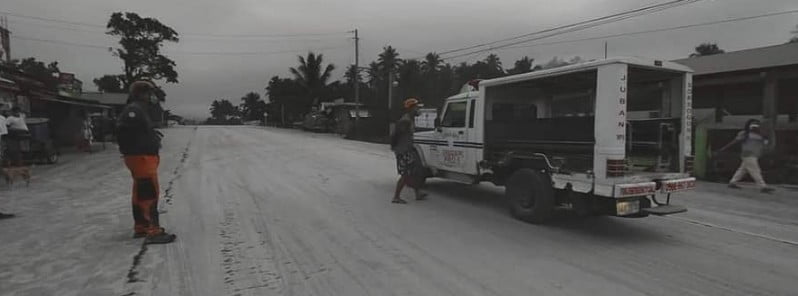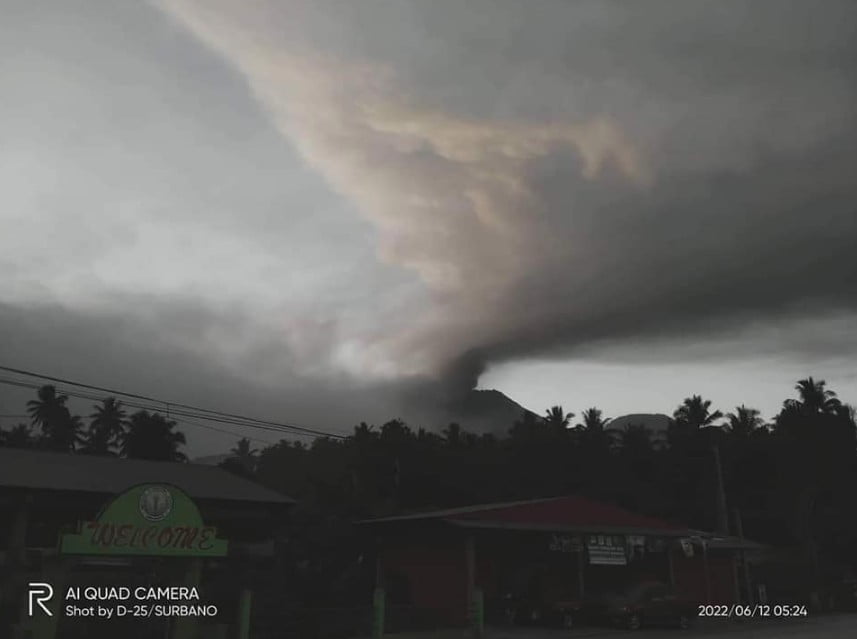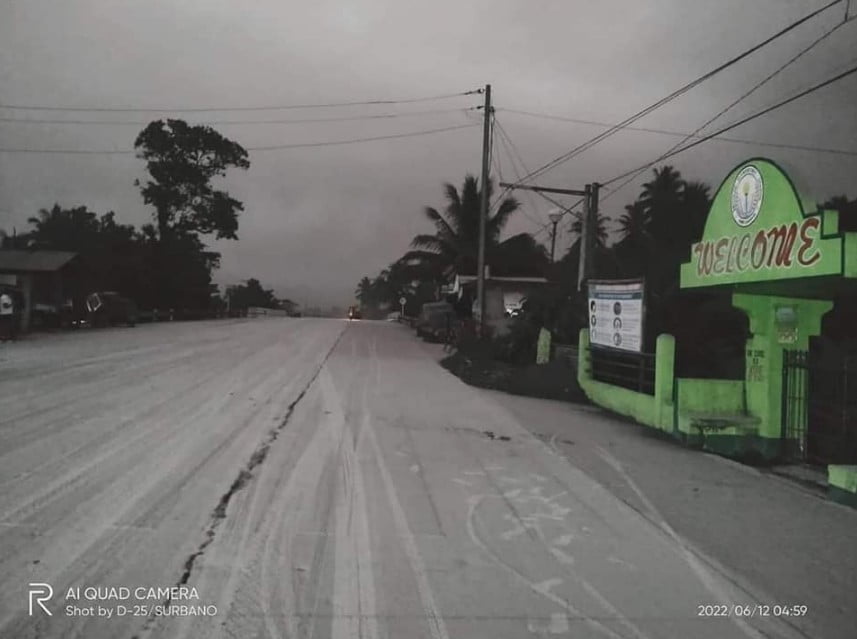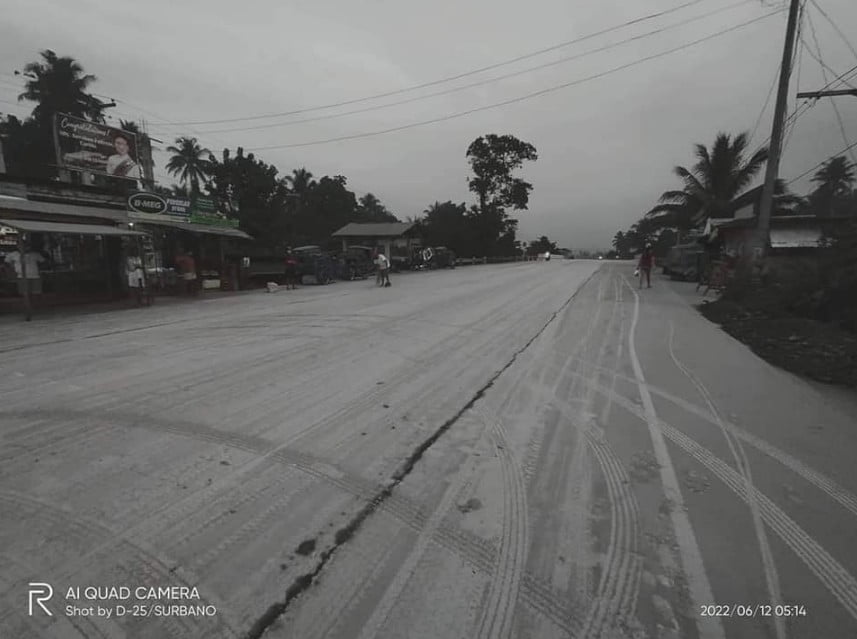New eruption at Bulusan volcano covers nearby communities in heavy ash, Philippines

A new phreatic eruption was detected by the Bulusan Volcano Network at 20:37 UTC on June 11, 2022 (03:37 LT on June 12). The event lasted 18 minutes based on the seismic record but the eruption plume was not visible in camera monitors. Bulusan’s last eruption took place on June 5, forcing PHIVOLCS to raise the Alert Level to 1.
Outgoing Sorsogon governor and Senator-elect Francis ‘Chiz’ Escudero said ash fall affected villages in the towns of Juban, Casiguran, and Magallanes.1
Escudero said the personnel of the Bureau of Fire Protection, police, and soldiers immediately started the clean-up along Maharlika Highway, especially in the villages of Bacolod and Rangas in Juban town which were affected by heavy ashfall.
Arian Aguallo, information officer of the municipal disaster risk reduction and management office of Juban, said at least 13 villages were affected by the ash fall in their town.
Based on the initial report, the heavily affected areas were villages of Añog, Puting Sapa, Bacolod, Buraburan, Catanusan, Calateo, Rangas, Sipaya and Aroroy, all in Juban.
Governor Chiz urged all residents to take extra precautions or avoid going through the Maharlika Highway in the town of Juban because of the thickness of ash.
According to the Tokyo VAAC, the eruption ejected ash to an estimated altitude of 5.2 km (17 000 feet) above sea level.
The explosion was felt at Intensity III by residents of Brgy. Añog, Juban and at Intensity II in Brgy. Inlagadian, Casiguran, all within 5 km (3.1 miles) of the Bulusan summit, PHIVOLCS said.2
Rumbling sounds accompanying the eruption were also reported by witnesses in Sitio Bagong Barrio, Brgy. Santa Lourdes, Barcelona, Brgy. Inlagadian and Brgy. San Juan, Casiguran, Brgy. Bentuco, Gubat, and Brgys. Añog, Calateo, and Puting Sapa, Juban.
A brief incandescence at the base of the eruption plume was also reported in Brgy. Inlagadian, Casiguran.
By daybreak, multiple active vents at the summit could be observed spewing ash and steam to a height of at least 500 m (1 640 feet) before being drifted to the northwest.
In the morning, six vents – the major crater called Blackbird, three explosion pits on the summit, and the lateral vents on the northwest and north sides of the summit – were actively degassing short plumes which entrained ash until at least 09:00 LT in the morning.
The plumes dispersed into a long veil of ash extending several kilometers to the northwest.
This period of “ashing” was accompanied by very weak sporadic volcanic tremor.
Degassing of steam-laden plumes continues while the Blackbird Crater generates a thin haze of ash upon the upper northwestern slopes.



In 24 hours to 05:00 LT on June 12, PHIVOLCS recorded 136 volcanic earthquakes, with plumes 150 m (492 feet) tall in moderate emission drifting west-northwest and northwest. As of June 10, the recorded sulfur dioxide (SO2) flux in the volcano was at 613 tons per day.
PHIVOLCS reminded concerned local government units (LGUs) and the public that entry to the 4 km (2.5 miles) radius Permanent Danger Zone is strictly prohibited and called for vigilance in the 2 km (1.2 miles) Extended Danger Zone on the southeast sector because of the increased possibility of sudden and hazardous phreatic eruptions.
A powerful phreatic eruption took place at Bulusan at 02:37 UTC (10:37 LT) on June 5, 2022. As a result, the Philippine Institute of Volcanology and Seismology raised the Alert Level for the volcano from 0 to 1.3
The previous eruption of this volcano was on June 5, 2017 (VEI 1) – exactly 5 years ago.
Geological summary
Luzon’s southernmost volcano, Bulusan, was constructed along the rim of the 11-km-diameter (6.8 miles) dacitic-to-rhyolitic Irosin caldera, which was formed about 36 000 years ago.
Bulusan lies at the SE end of the Bicol volcanic arc occupying the peninsula of the same name that forms the elongated SE tip of Luzon. A broad, flat moat is located below the topographically prominent SW rim of Irosin caldera; the NE rim is buried by the andesitic Bulusan complex.
Bulusan is flanked by several other large intracaldera lava domes and cones, including the prominent Mount Jormajan lava dome on the SW flank and Sharp Peak to the NE.
The summit of 1 565-m-high (5 134 feet) Bulusan volcano is unvegetated and contains a 300-m-wide (984 feet), 50-m-deep (164 feet) crater. Three small craters are located on the SE flank. Many moderate explosive eruptions have been recorded at Bulusan since the mid-19th century.4
References:
1 Sorsogon starts clearing ash in highways after Mt. Bulusan phreatic eruption – Inquirer – June 12, 2022
2 BULUSAN VOLCANO UPDATE – June 12, 2022 at 16:30 LT – PHIVOLCs
3 Powerful phreatic eruption at Bulusan volcano, Philippines – The Watchers – June 5, 2022
4 Bulusan – Geological summary – GVP
Featured image credit: PDERG


Commenting rules and guidelines
We value the thoughts and opinions of our readers and welcome healthy discussions on our website. In order to maintain a respectful and positive community, we ask that all commenters follow these rules.